A Discrete Paradigm for Design and Production.
We have never been digital
In “Breaking The Curve”, Mario Carpo describes the inherently discrete nature of computational processes, opposing it to the continuous logic of pre-computational, modern science (Carpo, 2014). Carpo describes how the 1990s generations of digital designers, or “Spline Makers”, are using essentially old differential mathematics and modern concepts such as geometry and topology. The following generation, as identified by Carpo, uses the discrete logics of computation – which he then relates to a new kind of science based on computational power. Building upon this distinction between the continuous and the discrete, this paper argues that perhaps – we have never been digital.1 Hinting at Nicholas Negroponte’s book “Being Digital” and Bruno Latour’s “We have never been Modern” – this provocation argues that architects have fundamentally misunderstood not only the nature of the digital, but also its economy and social implication.
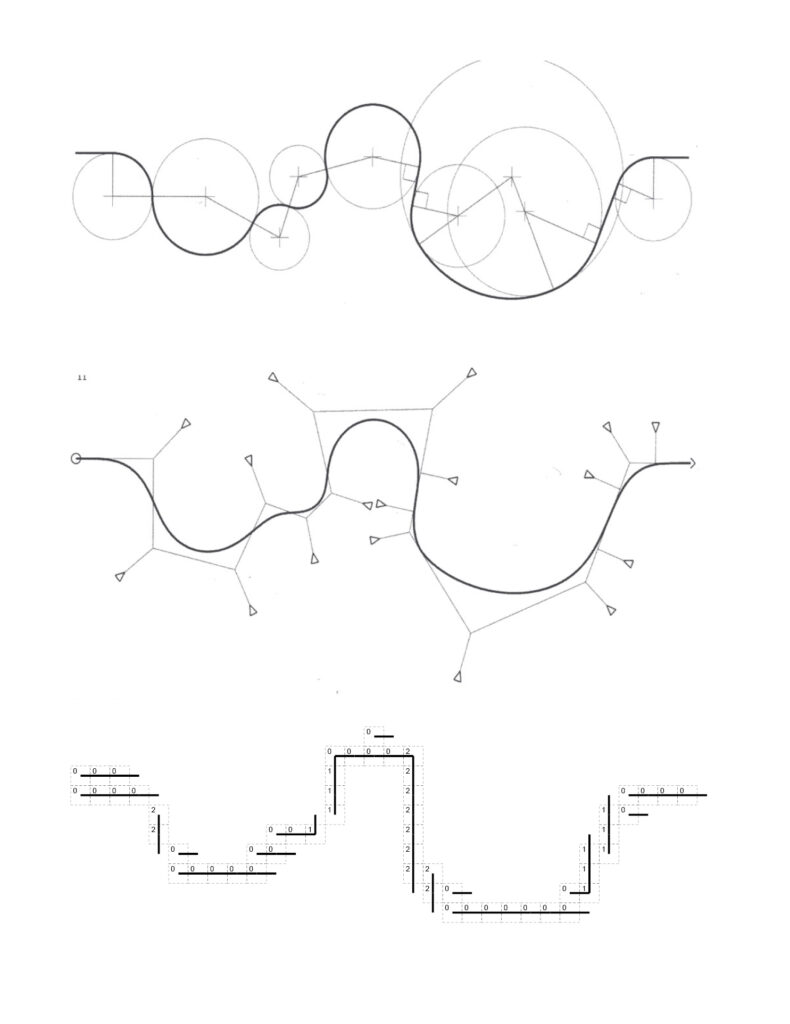
The work identified by Carpo as the Second Digital Age2 is only discrete to a certain extent. From the point of view of production, the work in fact still relies on continuous fabrication techniques. The notion of discreteness only exists in the design process, but to realise the resulting complex geometries, the architects have to rely on the same fabrication techniques as the previous generation: mass-customising segments, through either CNC-milling, robotic fabrication or 3D printing. For example, if a robot is used to carve a medieval sculpture out of a large block of stone, it is actually computerising a process that is a mere analogue. This harsh distinction between digital and analogue fabrication is convincingly argued for by Neil Gershenfeld (Gershenfeld, 2015). In order to be considered digital, a fabrication process has to operate on a material that itself is digital. Essentially, Mario Carpo’s distinction between the discrete and the continuous does not only exist in the digital world but also in the physical world. Digital data are based on discrete units with limited connection possibilities or whole numbers, whereas the continuous is based on infinite numbers. If all the elements in an organisation are discrete, serialised and relational elements with a limited connection possibility, then it can be defined as a digital organisation.

Continuing this logic, Carpo’s “Second Digital Age” does not operate with material that is digital. In fact, there is no notion of discreteness here, there is no unit or bit in the digital process which corresponds to a unit in the production process. There is no relation between the fabrication process and the design process – once finished, the resultant form has to be sliced up and rationalised in fabricatable data. It can be argued that until now, architects have only produced buildings with an analogue syntax. The experiments from the 1990s are still based on surfaces, on geometry, sliced in continuously differentiated segments. Their physical material organisation is analogue as well as the designed syntax.
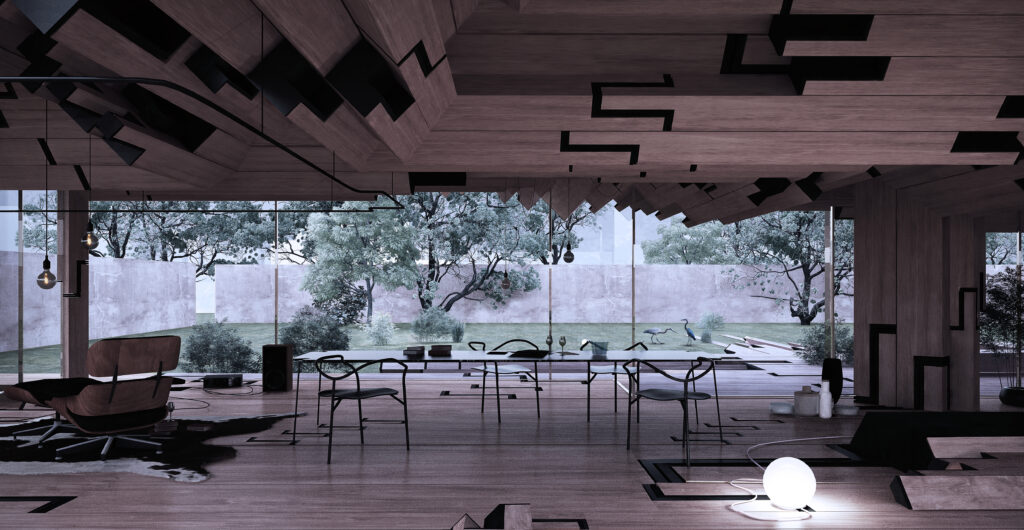
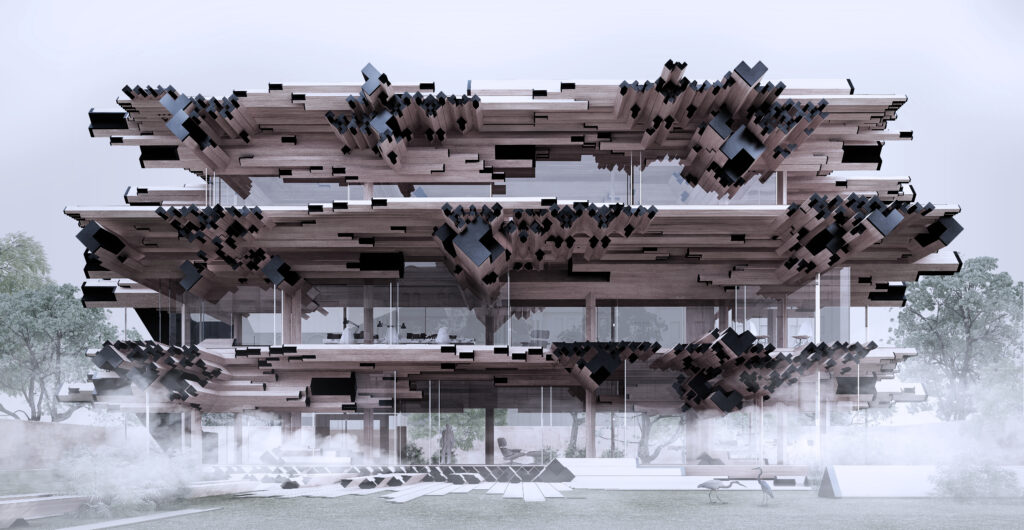
Digital Production
It could be argued that the architects’ misunderstanding of the nature of the digital finds its origin in digital production. Since the 1990s’ obsession with the CNC machine, digital manufacturing machines have been mainly understood as devices that allow to build thousands of self-similar but different variations at the same cost as an identical copy (Carpo, 2011). This idea of variation and differentiation formed a powerful argument opposed to the Fordist assembly line based on serial repetition (Lynn, 1999). Greg Lynn’s NURBS curve diagrams articulate this shift from modernist assembly to complete continuity, without a notion of parts. Similarly, an industrial robot arm offers the capability for precision and repetition. The architects’ discourse of difference was framed in a context of “mass-customisation”, an economic buzzword that was popular in the 1990s, which has since faded to the background of the discussion. It has been replaced by new concepts such as the Sharing Economy, Internet of Things, Big Data and the Platform. In fact, the architects of the 1990s also misunderstood the logic of mass-customisation itself as a form of formal differentiation, while it was actually thought of as an improvement in production chains. Today, the only commercially available item that is slightly customised along the lines of what the architects imagined is the Nike iD shoe, for which customers can choose a few different colours and textiles. The vast majority of other products are still standardised and in fact are becoming ever more standardised. For example, the majority of the world now uses only one or two types of cell phones – a situation not incomparable to Ford T. There is of course no need to customise the actual form or shape of your smart phone – why would you? What is customised is the content, the software, the apps you install. The real premise of digital production is not its ability to formally differentiate parts but its potential to cut production chains short and to distribute manufacturing. As Jeremy Rifkin describes, with digital production, basically any type of product could be produced without involving a whole array of machines, factories, subcontractors, suppliers etc. Quick variations or iterations of these products can be produced without any additional cost (Rifkin, 2014).
Being Digital
The architectural model closest to Rifkin’s idea of digital production is probably Wikihouse: a platform for an open-source house that can be produced out of small-scale elements, manufactured on cheap, self-built CNC machines which are also open-source. We see all the characteristics of a digital economy here: the idea of a wikipedia-like platform that brings together free information, distributed manufacturing, short production chains, and the ability to iterate. Of course, every Wikihouse can be slightly different – customised to the family and site, but fundamentally it has nothing to do with formal differentiation itself. Wikihouse is in this sense more “digital” than any parametric design or 1990s surface project. This is altogether a very different understanding of digital production compared to the mass-customised Nike shoe. Moreover, it has political implications: the agency for production and design, the platform, can be owned by people or cooperatives rather than large companies. Wikihouse is a clear example of how production can be democratised. It is this type of digital economy that forms the basis for what Paul Mason calls post-capitalism, the moment where freely available information products disrupt the artificial scarcity of the market.
Discrete and Digital Architecture
So can we imagine an architecture that is fully digital in its design, production, syntax and economy? This new kind of architecture would establish a digital syntax based on a set of versatile and recombinable bits or parts that can be manufactured and shared through a wiki-like platform of production. This digital syntax per definition rids itself of geometry and becomes purely based on relations. In the attempt of “being digital”, architecture inevitable escapes the surface and again gains access to discussions about modes of production – which allows the discourse to take part in a larger discussion about the social and political consequences of the digital. These building blocks act the same way as digital data, which means that they can be recombined, are reversible, universal and versatile. The first experiment with this fully digital project is the Diamond House (2016), a project for a multi-family home in Wemmel, Belgium. The project is based on an L-shaped and a rectilinear element with male-female connections. The elements are hollow, assembled out of timber sheet material. In principle, they could be produced on a small CNC-Router, as a form of distributed manufacturing. The elements are hierarchically scalable, which means that they can appear at the same time on multiple different scales. Just as the other examples – we first assume a space filled up with points that can contain data such as stress, vectors etc. Each voxel is linked to a digital building block, which for example orients in the direction of the vector or could obtain a specific position based on the neighbouring voxels. A syntax emerges from the relations between elements. Greg Lynn’s NURBS curve diagram now becomes a volumetric, voxelized cloud of data. The content of the voxel can be varied as well as the size or resolution of the voxel space.

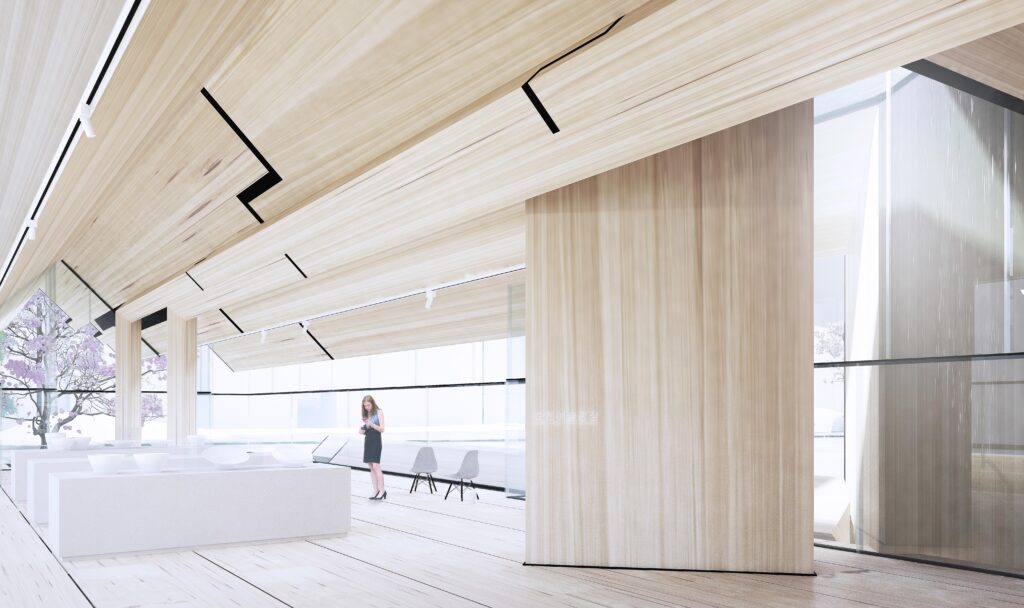

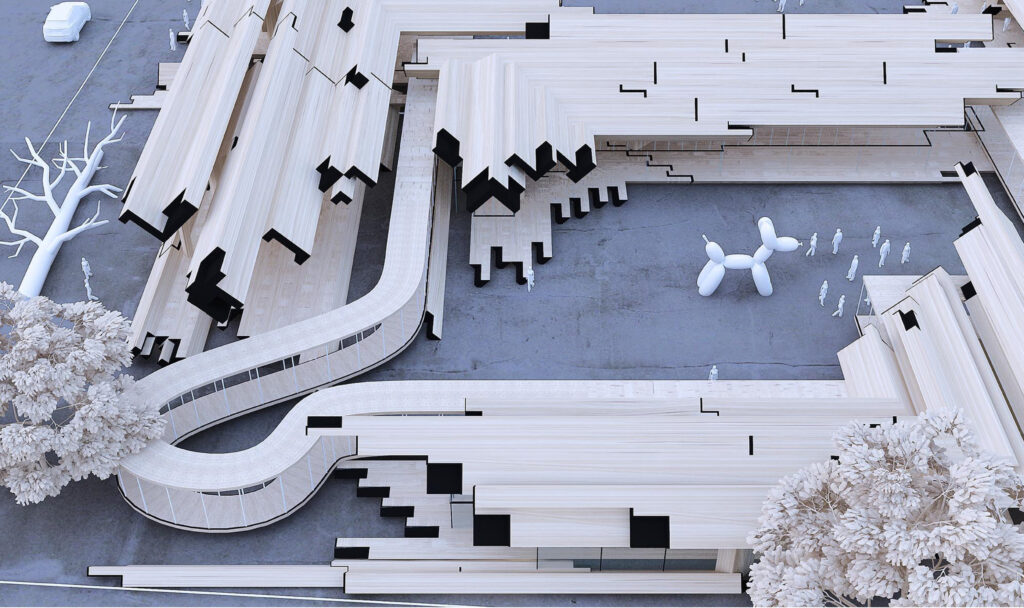
This approach is further explored in the competition proposal for the Suncheon Art Platform (2016), which uses large-scale building blocks. These blocks are made of timber panels with internal stiffening frames. Services such as ventilation and museum lighting are integrated in the blocks. The competition proposal explores the implications of a lower resolution, arguing that the most important aspect is the syntax. So although the resolution is low and the building may at times seem almost minimal – it is still a digital material organisation, syntactically the same as the Diamond House. The Suncheon Art platforms argues that resolution or scale is not as important as syntax. The lower resolution syntax in the Suncheon Art Platform emphasizes the shift from an emphasis on whole to an emphasis on parts. The building has a strong and clear figure, but at the same time this figure remains diffused and open – it could expand, contract etc. There is a blurry, albeit pixelated boundary between the outside environment and the inside. So, instead of a subdivision of the whole, sliced into a large amount of customised parts, we now have a building form that is in conversation with the part and whole – these are democratically situated on the same plane

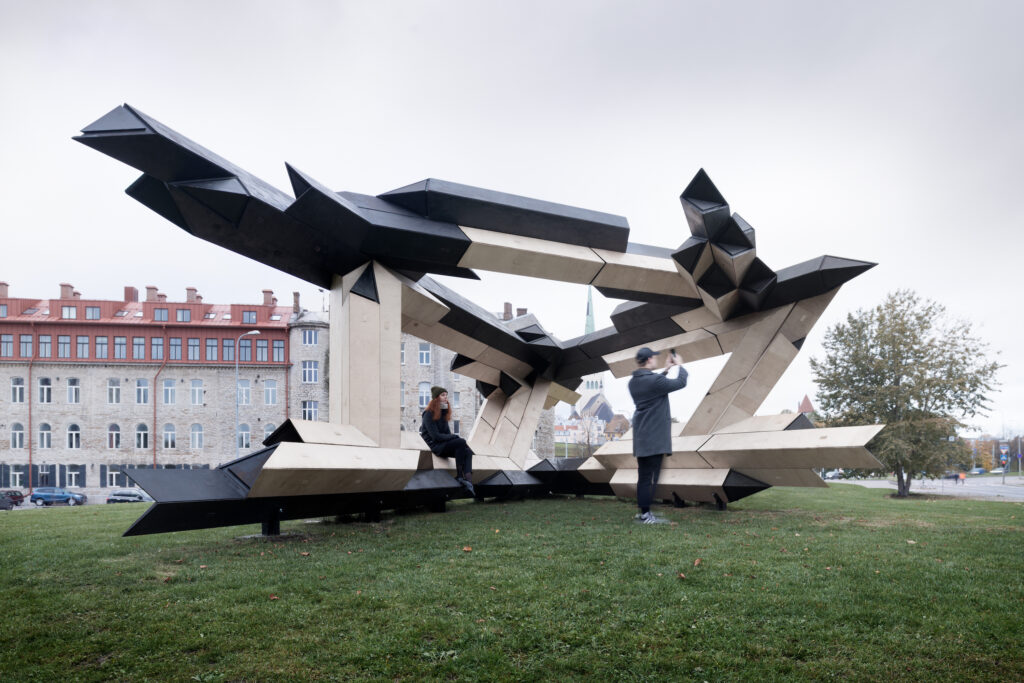
The Tallinn Architecture Biennale pavilion (2017) presented an opportunity to materialise the ideas described above. The pavilion is based on a just a few, Lego-like pieces that can act as both column, beam and cladding at the same time. These discrete building blocks are made of cheap, off-standard sheets of 18mm exterior plywood (3.3 x 1.35 m) that were locally available. Each sheet is cut by a CNC-machine and then assembled into a stiff building block capable of bearing structural loads. The blocks exist as a family of straight 45-degree, 90-degree and 135-degree elements. These building blocks are designed to perform “just good enough” in any structural condition: under compression, tension, as a cantilever or as a column. Over 380 m2 of plywood was cut and assembled into 80 building blocks. The entire structure was fabricated locally in Tallinn in collaboration with local manufacturers.
Similar to a brick-bond, these discrete building blocks can be combined together into a staggered pattern, able to produce large beams and spans. The connection is based on off-the-shelf threaded rods used in suspended ceilings or to hang cable gutters. These rods connect through several pieces, forming a stiff structure under tension. The blocks can be quickly assembled on site, using only a set of ratchet-spanners and bolts. The assembly remains reversible, it can be modified or taken apart afterwards.
The pavilion is meant more a case-study or prototype of a construction system rather than a finished form. In that sense it is similar to Le Corbusier’s Maison Domino: an abstract model of a larger, recombinable and repeatable construction system. In contrast to the typical shell or surface-like parametric pavilions, this one wants to be understood as a part of a larger whole, a unit in a mass-housing system. The horizontal organisation hints at the fact that it could be stacked and repeated in multiple directions. The pavilion is never finished: it remains an open and adaptable whole. The structure could be finished with a roof or facade and continue its life afterwards as a cabin, pedestrian bridge or house in another location.
The digital workflow behind the pavilion enables a low-cost, fast and open production-chain. With the help of digital fabrication tools, an initially weak material is turned into a versatile and structural building block that can be assembled by anyone, with almost no tools. This construction method is scalable and could be applied for housing solutions on a larger scale using stronger materials such as CLT (cross laminated timber) or LVL (laminated veneer lumber) – as shown in the Diamonds House and the Suncheon Art Platform.
The TAB pavilion is fully digital – in the design process, as a material organisation, syntax, and as an economic model or production. Apart from the more architectural questions related to syntax and part-to-whole relations, the focus on digital production beyond mere formal differentiation sets up a discussion about the potential social agency of this tools. It enables the possibility for architects to engage the digital in a larger social discussion. At the same time, the focus on parts, composition and syntax keeps this discussion firmly grounded in design. In the digital-discrete, the political engagement is integrated: digital fabrication tools are understood as a way to engage with modes of production and therefore also social and political ideas. Rather than an isolated conversation about material behaviour and structural performance, architects can use their understanding of digital workflows to contribute ideas to a vivid cultural and political debate about the future of capitalism, automation, the status of the city, housing etc.
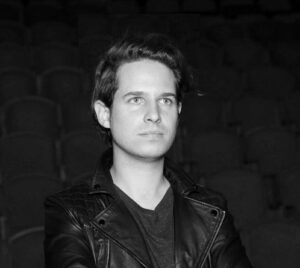
GILLES RETSIN is a London-based architect, designer and educator. His work is interested in the impact of emerging technologies on the core principles of architecture. He is Program Director of the B.Pro Architectural Design (AD) and co-founder of the Design Computation Lab at UCL the Bartlett School of Architecture in London. Gilles Retsin studied architecture in Belgium, Chile and the UK, where he obtained his Master’s at the Architectural Association (AA) in London.
HEADER phohto by Paco Ulman.
PUBLISHED in Maja’s 2018 spring edition (No 93).
- Carpo, M. (2014). Breaking the Curve. Big Data and Digital Design. In Artforum 52, 6. pp. 168-173.
- Carpo M. (2011) The Alphabet and the Algorithm, MIT Press
- Gershenfeld, N., Carney, M., Jenett, B., Calisch, S. and Wilson, S. (2015) ‘Macrofabrication with digital materials: Robotic assembly’, Architectural Design, 85(5), pp. 122–127. doi: 10.1002/ad.1964.
- Eisenman, P (1976) “Post-Functionalism”, Oppositions 6, MIT Press, pp 236-239
- Latour, B. (1991) We Have Never Been Modern, Harvard University Press
- Lynn, G. (1999) Animate Form. New York: Princeton Architectural Press
- Mason, P (2015) PostCapitalism: A Guide to our Future, Princeton Press
- Rowe, C. (1947) The Mathematics of the Ideal Villa, reprinted in Rowe, C. (1976) The Mathematics of the Ideal Villa and other essays, the MIT Press
- Rifkin, J. (2014) The Zero Marginal Cost Society, Palgrave Macmillan Trade
1 “We have never been digital” and the link with Latour and Negroponte was first used by Thomas Haigh in the context of digital humanities. The statement here does not refer to Thomas Haigh’s article which is rather skeptical of the impact of digital technologies.
2 Carpo refers to the work of EZCT, Biothing, Kokkugia and Michael Hansmeyer.





